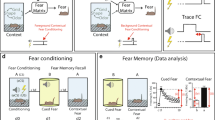Abstract
A number of commonly used inbred strains were surveyed in a fear-conditioning paradigm conducted with an automated computer-controlled system. Control studies were used to verify the automated system. Response to shock was also monitored to determine if it was associated with contextual and/or cued conditioning behavior. After three pairings of tone with shock, fear conditioning was measured 24 h later in 129S1/SvImJ (129), A/J (A), BALB/cByJ (BALB), C3H/HeJ (C3H), C57BL/6J (B6), CBA/J (CBA), DBA/2J (D2), and FVB/NJ (FVB) male and female mice. There were both significant strain and sex differences in response. To determine the effects of vision on this behavior, C3H mice (with retinal degeneration) were compared with C3.BLiA-+Pde6b congenics (without retinal degeneration). Here, vision was found to play a minimal role in responsiveness in this paradigm. Because this fear-conditioning test is automated, it can be used for the rapid screening of a large number of mice, such as required for mutagenesis studies.
Similar content being viewed by others
Author information
Authors and Affiliations
Additional information
Received: 23 December 2000 / Accepted: 18 April 2001
Rights and permissions
About this article
Cite this article
Bolivar, V., Pooler, O. & Flaherty, L. Inbred strain variation in contextual and cued fear conditioning behavior. Mammalian Genome 12, 651–656 (2001). https://doi.org/10.1007/s003350020039
Published:
Issue Date:
DOI: https://doi.org/10.1007/s003350020039




